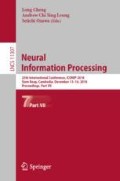Abstract
Computing the semantic similarity accurately between words is an important but challenging task in the semantic web field. However, the semantic similarity measures involve the comprehensiveness of knowledge learning and the sufficient training of words of both high and low frequency. In this study, an approach MedSim is presented for semantic similarity measures to identify synonym terms in medical text with effectiveness and accuracy well-balanced. Experimental results on Chinese medical text demonstrate that our proposed method has robust superiority over competitors for synonym identification.
Access this chapter
Tax calculation will be finalised at checkout
Purchases are for personal use only
References
Bengio, Y., Schwenk, H., Senécal, J.S., Morin, F., Gauvain, J.L.: Neural probabilistic language models. In: Holmes, D.E., Jain, L.C. (eds.) Innovations in Machine Learning. Studies in Fuzziness and Soft Computing, vol. 194, pp. 137–186. Springer, Heidelberg (2006). https://doi.org/10.1007/3-540-33486-6_6
Christensen, J., Pasca, M.: Instance-driven attachment of semantic annotations over conceptual hierarchies. In: Proceedings of the 13th Conference of the European Chapter of the Association for Computational Linguistics, pp. 503–513. Association for Computational Linguistics (2012)
Gábor, K., Zargayouna, H., Tellier, I., Buscaldi, D., Charnois, T.: Exploring vector spaces for semantic relations. In: Proceedings of the 2017 Conference on Empirical Methods in Natural Language Processing, pp. 1814–1823. Association for Computational Linguistics (2017)
Islam, A., Inkpen, D.: Semantic text similarity using corpus-based word similarity and string similarity. ACM Trans. Knowl. Discov. Data 2(2), 1–25 (2008)
Islam, M.A., Inkpen, D.: Second order co-occurrence PMI for determining the semantic similarity of words. In: Proceedings of the International Conference on Language Resources and Evaluation, pp. 1033–1038 (2006)
Krishnan, R., Hussain, A., Sherimon, P.C.: Retrieval of semantic concepts based on analysis of texts for automatic construction of ontology. In: Huang, T., Zeng, Z., Li, C., Leung, C.S. (eds.) ICONIP 2012. LNCS, vol. 7663, pp. 524–532. Springer, Heidelberg (2012). https://doi.org/10.1007/978-3-642-34475-6_63
Lei, K., Si, S., Wen, D., Shen, Y.: An enhanced computational feature selection method for medical synonym identification via bilingualism and multi-corpus training. In: IEEE International Conference on Big Data Analysis, pp. 909–914 (2017)
Medrouk, L., Pappa, A.: Deep learning model for sentiment analysis in multi-lingual corpus. In: International Conference on Neural Information Processing, pp. 205–212 (2017)
Mendes, A.C., Wichert, A.: From symbolic to sub-symbolic information in question classification. Artif. Intell. Rev. 35(2), 137–154 (2011)
Mikolov, T., Yih, W.T., Zweig, G.: Linguistic regularities in continuous space word representations. In: HLT-NAACL (2013)
Pasini, T., Navigli, R.: Train-o-matic: large-scale supervised word sense disambiguation in multiple languages without manual training data. In: Proceedings of the 2017 Conference on Empirical Methods in Natural Language Processing, pp. 78–88. Association for Computational Linguistics (2017)
Pei, J., Zhang, C., Huang, D., Ma, J.: Combining word embedding and semantic lexicon for chinese word similarity computation. In: Lin, C.-Y., Xue, N., Zhao, D., Huang, X., Feng, Y. (eds.) ICCPOL/NLPCC -2016. LNCS (LNAI), vol. 10102, pp. 766–777. Springer, Cham (2016). https://doi.org/10.1007/978-3-319-50496-4_69
Pennington, J., Socher, R., Manning, C.: Glove: global vectors for word representation. In: Conference on Empirical Methods in Natural Language Processing, pp. 1532–1543 (2014)
Socher, R., et al.: Recursive deep models for semantic compositionality over a sentiment treebank (2013)
Virk, S.M., Muller, P., Conrath, J.: A supervised approach for enriching the relational structure of frame semantics in framenet. In: Proceedings of COLING 2016, the 26th International Conference on Computational Linguistics: Technical Papers, pp. 3542–3552. The COLING 2016 Organizing Committee (2016)
Wang, W., Alkhouli, T., Zhu, D., Ney, H.: Hybrid neural network alignment and lexicon model in direct HMM for statistical machine translation. In: Proceedings of the 55th Annual Meeting of the Association for Computational Linguistics, vol. 2: Short Papers), pp. 125–131. Association for Computational Linguistics (2017)
Yin, Y., Song, Y., Zhang, M.: Document-level multi-aspect sentiment classification as machine comprehension. In: Proceedings of the 2017 Conference on Empirical Methods in Natural Language Processing, pp. 2044–2054. Association for Computational Linguistics (2017)
Acknowledgements
This work has been financially supported by Guangdong Pre-national project (Grant No.: 2014GKXM054), the National Natural Science Foundation of China (No. 61602013), and the Shenzhen Key Fundamental Research Projects (Grant No.: JCYJ20170818091546869).
Author information
Authors and Affiliations
Corresponding author
Editor information
Editors and Affiliations
Rights and permissions
Copyright information
© 2018 Springer Nature Switzerland AG
About this paper
Cite this paper
Lei, K., Huang, J., Si, S., Shen, Y. (2018). Semantic Similarity Measures to Disambiguate Terms in Medical Text. In: Cheng, L., Leung, A., Ozawa, S. (eds) Neural Information Processing. ICONIP 2018. Lecture Notes in Computer Science(), vol 11307. Springer, Cham. https://doi.org/10.1007/978-3-030-04239-4_36
Download citation
DOI: https://doi.org/10.1007/978-3-030-04239-4_36
Published:
Publisher Name: Springer, Cham
Print ISBN: 978-3-030-04238-7
Online ISBN: 978-3-030-04239-4
eBook Packages: Computer ScienceComputer Science (R0)

